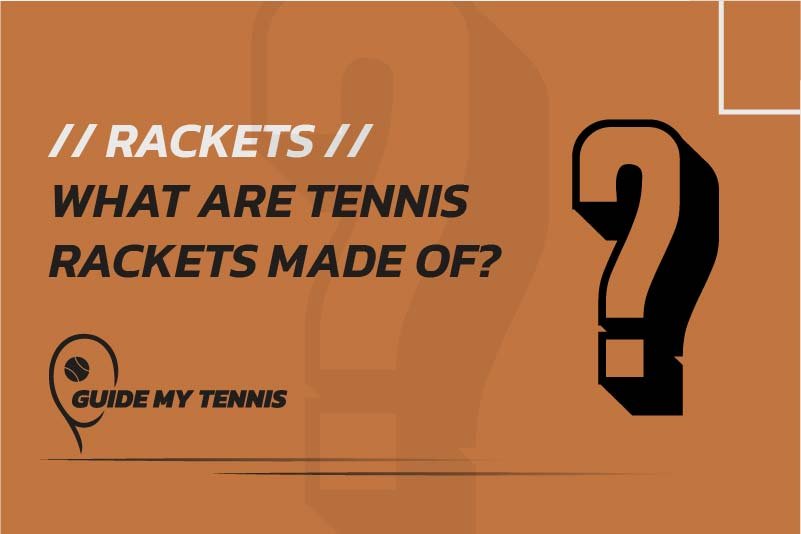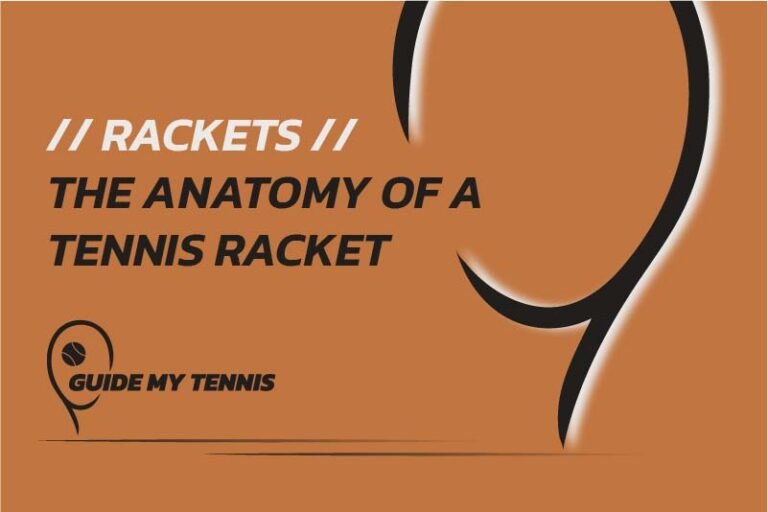From Wood to Graphite: What are Tennis Rackets Made of?
Did you know that the tennis racket has undergone more transformations than almost any other sports equipment? It’s a piece of sporting beauty that carries with it a lot of history. Scroll down to learn further the history of tennis rackets, how old tennis rackets were created and understand the properties of the materials that make up today’s graphite tennis racket.

Do you know the answer to the question “What are tennis rackets made of?”
You don’t? Don’t worry – Guide My Tennis is here to help out. Let’s start with something easy.
Did you know that the tennis racket has undergone more transformations than almost any other sports equipment? It started out as just a piece of wood. But now, after numerous technological improvements were added, we have an advanced piece of tennis equipment. A sporting marvel made from the strong and sturdy materials that are graphite composites. The tennis racket tells a story of innovation, design, and passion for the game.
The Dawn of Tennis: What are Tennis Rackets Made of?
Imagine playing tennis with a handcrafted wooden racket and a hard leather ball.
Yep, you read that right.
Some say that the first form of tennis materialised sometime in the 11th century. French monks used to bounce a leather ball and try to hit it with their hands. A more popular belief is that tennis was created in France and made popular by King Henry VIII of England, who built his own tennis court in London.
In the past, the sport was played a bit differently than we know it today. The court was an indoor space surrounded by 4 walls. In addition to that, the rackets that were used were like long wooden paddles. One can say that it was a hybrid of what tennis and squash are nowadays.
Tennis was actually referred to as Real Tennis – but was there a fake tennis?
Let’s be honest, the real question is “what did they use as a tennis racket?”
The answer lies below. let us take a look to understand the question “What are tennis rackets made of?”
Evolution of Materials: From Wood to Graphite and Beyond
The first racket to be properly created was made of wood in the 19th century. Over time, different wooden materials were being used and this allowed players to have some form of control over the racket’s specs.
Various pieces of wood were used to form the shape of the tennis racket. The pieces were glued together to form the shape of a key-hole. At first, ash was deemed as the perfect choice, simply because of its strength and malleable level – that is the ability to be pressed into shape.
In addition to ash, other wooden materials, such as maple, sycamore and hornbeam were being used as well. These materials allowed players to achieve better stiffness properties, improve the strength of the frame and even alter the racket’s balance. This was done by using obeche, a lightweight wood that was used as a filler for the shaft.
The international governing body of tennis, known as ITF, understood that different shapes could be achieved by using different material. In fact, once the industry standardised the tennis racket’s shape and optimum specifications, it started mass producing this sporting good.
However, very soon, the industry turned its gaze towards new materials. That is when the ITF (International tennis Federation) started setting parameters to limit what can be achieved through a tennis racket.
The Arrival of Metal Frames
In 1979, metals started being used successfully and quickly killed the wooden racket in the early 1980’s.
The reality is, that metals were already being used in the early 1900. However, metal frames were proving to be too complex to string. However, in 1953, Lacoste devised and patented the solution to this. The string was made to loop around the frame and retain its tension. Lacoste went on to introduce the LR07, what they claim the world’s first metal racket.
This patent was key to the creation of the Wilson T2000, a tennis racket that was deemed as the first commercially successful metal tennis racket. This was in fact used by Jimmy Connors in his triumphant runs in Wimbledon of 1974 and 1981.
Materials such as aluminium alloys and carbon-steel were used to usher in the new era of tennis rackets. Plastic grommets were in fact created to combat the sharp edges that these materials were producing. You see, a tennis racket that can easily snap its strings because of its build was not going to be successful. Therefore, these plastic shells, called grommets, were invented.
But technology waits for no one and as time passed, better tech and new resources were made available for use. Now, the question “What are tennis rackets made of?”, was on everyone’s mouth.
What Are Tennis Rackets Made Of Today?
Mass production of metal tennis rackets led to further experimentation with tennis rackets and their materials. Glass fibre and carbon fibre were the new contenders. The latter is also commonly known as graphite in the sports world. Both glass fibre and especially graphite, were found to have better strength and durability than aluminium alloys and other metals that were used. Subsequently, this allowed for further racket enhancements.
The popularity of glass fibre and graphite soared in recent years, and these composite materials allowed rackets to have a larger head size, a stiffer frame, a lighter load and over all, a more sturdy feel.
The larger head allowed players to hit the ball with more force whilst decreasing their errors. The increased stiffness made the rackets feel comfortable while absorbing the hits of the ball. The lightness in the frame allowed players to push their bodies to produce more power whilst limiting injuries. The composite materials that tennis rackets are made with nowadays have a great advantage over old tennis rackets, particularly, the wooden tennis rackets.
Did you know? The ITF states that a current composite racket can have a 40% larger head, be 3 times stiffer and 30% lighter than the most highly developed wooden version.
I Know the Answer to “What are Tennis Rackets Made of?” – Now What?
Okay, so you are now knowledgeable of where the tennis racket comes from. That’s great. You are one step closer to understanding what tennis racket best suits you. Your next step is to understand How to Choose a Tennis Racket and Discover Tennis Racket Anatomy. In fact, these readings are highly recommended by myself, your online tennis coach, to help you understand what specs suit your skill level in tennis.
How do Tennis Racket Materials affect the Players’ Game?
Well, we know that the tennis racket went through some drastic changes, from old heavy rackets with a small head size, to the new light and stiff tennis racket that has a 40% larger head size. These changes impacted the way a tennis player manoeuvres the tennis racket on court. Subsequently, technological advancements also pushed tennis players to adopt and develop various tennis strategies and tactics.
As a matter of fact, there are 4 different types of tennis players. These are:
- The Counterpuncher
- The Aggressive Baseliner
- The Serve and Volley Play
- The All Rounder
These are the 4 fundamental plays that a tennis racket builds their profile on.
When old wooden tennis rackets were popular, the serve and volley was a popular technique which was perfected by the likes of Billie Jean King. Since wooden rackets were significantly heavier and produced less power, it allowed players to serve wide and go up to the net to hit a volley in the open court.
Nowadays, carbon fibre is allowing players who favour aggressive shots from the baseline. The reason being that carbon fibre is lighter and is allowing tennis racket manufacturers to create larger tennis rackets which produce more power while being light. This significantly reduced the number of serve and volley plays among the ATP and WTA pros.
Are you a counterpuncher? Find out here!
Concluding The Answer
As we’ve seen, the tennis racket is more than just a piece of sports equipment; it’s a symbol of technological advancement and the enduring spirit of the game. This blog post goes over the question “What are tennis rackets made of?” If you want more information on tennis rackets, maybe you are on the hunt to purchase one, or maybe you want to find a suitable junior tennis racket for your younger tennis pal, then you are in for a treat. Guide My Tennis is your one stop information hub for all tennis related queries.
And hey, before you leave, I just want to give a small shoutout to ITF and for their commitment to tennis. This blog includes several points pointed out by ITF and their guide on tennis racket history. See it here.





